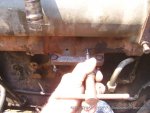kaiser2help
Member
- 182
- 3
- 18
- Location
- East Freetown, MA
A much debated topic. Being a diesel mechanic it does make sense to mount the temp probe in the pre-turbo location. However, most leading truck manufacturers for years have always mounted their's post turbo. Mack, CAT, Cummins, Int'l, and many others mount it post turbo. Also if one were to mount it pre turbo sure its a good idea to remove the turbo. But being that the manifold is cast this material does cut, tap, and drill quite differently from most ferrous materials. I have a LDS 465-1A for the application. Couldnt one start the engine let it idle to create a little back pressure ( positive pressure in the manifold) and drill with patience, periodically clearing the flutes of the drill bit? Most cast iron when it is drilled produces a powdery type filings . I am sure there has been larger carbon particles that have gone through the turbo that are much harder than cast drill shavings. Same would be for tapping the manifold. Grease the flutes and go easy. If anyone can elaborate on this one I could use the help. Thanks.




